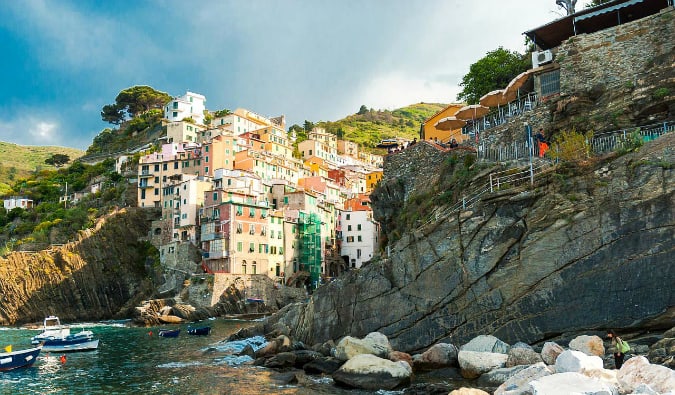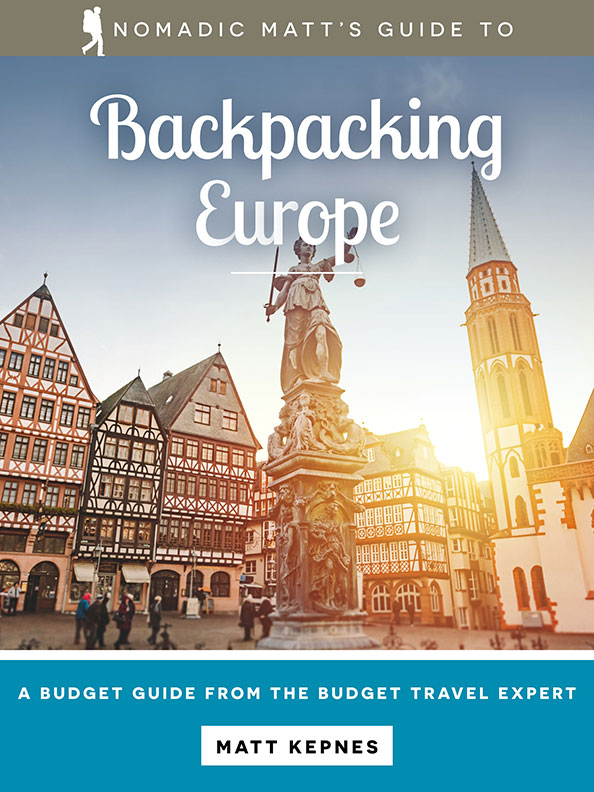

Updated: 05/27/18 | May 27th, 2018
Europe. It’s an expensive place and prices vary greatly depending on how far north, east, south or west your travel. Europe covers a huge area of the world with multiple visa zones and multiple currencies. For 20 euros, you can get a private room in Greece. For that same price in Paris, you may get a 16 person dorm room. You can eat for a few euros in Spain or Hungary, but a sit-down meal in Italy will cost around 15 euros, and triple that in Norway!
I’ve been going to Europe for close to ten years now.
A trip to Europe isn’t cheap, but there are plenty of ways to cut down costs. Since Europe is so big, today I want to talk about traveling around Western Europe and the Eurozone countries.
One of the most asked questions I get is “how much does it cost to travel to Europe?”
Well, today, let’s talk about planning a trip to Europe!
How much do things cost?
Here are some general costs for things in Europe, because as I said, prices can vary a lot depending on where you are:
- Accommodation: In most Western European countries, expect to pay 25–35 euros per night for a dorm room. (Though in Greece and Spain, it’s only 10–20 euros per night.) In Scandinavia, expect to pay around 30–35 Euros per night. In England, prices are usually around 20–30 pounds per night.
- Food: Food costs vary as wildly as accommodation costs. Cheap fast food meals cost 9–15 euros, while restaurants meals cost around 15–25 euros. Nicer establishments will cost 30 euros or more. You can cook your food for a week for around 65 euros>.
- Transportation: The easiest way to get around Europe is by train. Trains connect every major part of Europe, and they’re often very cheap. High-speed trains, though, can cost over 100 euros. Try to get the regional or slow trains for cheaper prices! The rise of cheap airlines like Ryanair, EasyJet, and Transavia has made flying around Europe in a hurry really cheap. For flights, expect to pay around 50 euros if you book in advance. Transportation around most cities is only 1–2 euros.
- Activities: Most museums and tours start at around 14 euros. It’s cheaper, of course, in eastern Europe. Full-day tours cost 35–100 euros. Prices vary drastically per country, so it’s hard to give a good general cost of this budget item.
How to Save Money in Western Europe


- Picnic – Europe has a lot of tiny shops where you can be premade sandwiches or ingredients to make your own. Buy some food, eat outside, and watch the city go by. It’s a cheaper and more enjoyable way to eat.
- Eat Local and Cheap – Not into picnicking? That’s OK, there are other ways to save money on food. Eat at local sandwich shops, pizza parlors, Maoz, Wok to Walks, outdoor street vendors, and the like. Avoiding restaurants and eating at a lot of the local “grab ‘n go” places will give you a taste of the local cuisine at a much cheaper price.
- Couchsurf – Hostels can add up really quick in Europe. If you don’t have any friends you can stay with, consider using the service Couchsurfing, which lets you connect with locals who will let you stay with them for free.
- Fly Cheap – If you know where you’re going and a train won’t do, try to book flights early. You can often get one-euro fares from many of the discount airlines like Transavia, Easyjet, Air Berlin, and Ryanair. MORE: There are many cheap ways to get across Europe.
- Drink Less – Those five-euro beers really add up. Hit happy hour or pick and choose when you party. Hostel bars are a good place to get cheap drinks, or you can buy your alcohol at the supermarket. Partying your way across the continent will destroy your bank balance in no time.
- Take the Free Tours – One of the great things about Europe is that you can find free walking tours in all the major cities. They can be a great way to see the city attractions, learn some history, and get your bearings without spending any money. Almost every city in Europe has a free walking tour available. Your hostel or the tourism board will have details!
- Camp in a garden – A very good camping service specific is Campspace (formerly Camp in My Garden), which allows you to pitch a tent in someone’s backyard for free or a nominal fee (around 4-10 EUR). This is a new service that started in 2010 but more and more people are signing up for it each day. All of the garden owners have profiles that tell you what services and facilities they offer.
- Get a Rail Pass – Eurail Passes have saved me hundreds of dollars when I used them. If you are traveling far distances and through many countries, they are a great deal. Here’s more information how to pick a Eurail pass.
- Get a city tourist card – Local tourism offices issue a tourist card for all their attractions, tours, and restaurants. This card gives you free entry and substantial discounts on all the attractions and tours in a city, free local public transportation (a huge plus), and discounts at a few restaurants and shopping malls. They save a ton of money. If you plan on doing a lot of sightseeing, get one of these cards.
- Rideshare – Hugely popular and widespread in Europe, I did this to get around Switzerland, France, and UK. BlaBlaCar, the biggest website, connects drivers and riders and lets you get around much cheaper than a bus or train. Moreover, this way is amazing for getting off the highways, seeing more the countryside, and meeting locals. It’s money-saving and much more exciting than taking the train or bus!
What’s a good daily budget in Europe?


Recently, I went through Amsterdam, Greece, Italy, and Hungary. In 59 days of traveling, I spent 4,317 euros, which averages out to 73.17 euros per day. That includes a few flights, many a nice meal, too many drinks on Ios, a few nights of private rooms (it was my birthday, after all!), and some unexpected purchases (a jacket, a new iPhone charger, and new headphones).
So how much does it cost to travel Europe?
On a backpacker budget, if you were avoiding flights, occasionally Couchsurfing, staying in cheap dorms, and cooking most of your meals, you could average between 40-50 Eur per day. It would be a tight budget but you could definitely do it. One of the biggest costs in Europe is accommodation so reducing that cost will help a lot!
However, if you wanted some flexibility in your schedule, planned to eat out only stay in hostels, and visit a lot of places, plan for around 70 euros a day.
If you’re going to stay in only private rooms or Airbnb as well as eat at sit down restaurants every meal, I’d say budget closer to 100 euros to be safe.
***A trip to Western Europe can cost a lot of money. It’s never going to be a cheap area of the world to travel but with some smart money management and follow the tips in this post, Western Europe can become at least an affordable place to visit. Control your costs and you can be able to see anything!
Get Your In-Depth Budget Guide to Europe!

 My detailed, 200+ page guidebook is made for budget travelers like you! It cuts out the fluff found in other guidebooks and gets straight to the practical information you need to travel and save money while backpacking around Europe. You’ll find suggested itineraries, budgets, ways to save money, on and off the beaten path things to see and do, non-touristy restaurants, markets, and bars, and much more! Click here to learn more and get started!
My detailed, 200+ page guidebook is made for budget travelers like you! It cuts out the fluff found in other guidebooks and gets straight to the practical information you need to travel and save money while backpacking around Europe. You’ll find suggested itineraries, budgets, ways to save money, on and off the beaten path things to see and do, non-touristy restaurants, markets, and bars, and much more! Click here to learn more and get started!
Also look at my other Europe guides:
View all my guides —>
没有评论:
发表评论